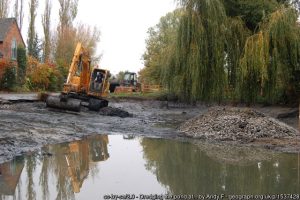This blog has been written by The Flood Hub People.
For decades, dredging rivers was seen as the solution to flooding. By digging out riverbeds and making channels deeper and wider, communities believed they could keep rivers flowing and manage flood risk. But over time, this approach has proved costly, environmentally damaging, and often ineffective.
Today, dredging is rarely used in the UK, replaced instead by more sustainable, catchment-based approaches. Where intervention in rivers is still necessary, gravel removal is now the preferred method. This blog explores why dredging has been largely phased out, the impacts it caused and why gravel removal has become its replacement.
The History of Dredging
Dredging, the large-scale removal of sediment from riverbeds, has been carried out in the UK since the 18th century. In addition to managing flood risk, it was used to keep waterways navigable, improve drainage for farmland, abstract gravel and sand for construction, and maintain flows to mills.
In the mid-20th century, dredging became widespread as a flood defence measure. However, by the late 1980s, its drawbacks were becoming clearer, and it was largely phased out as a primary flood management tool.
What is Dredging and Why Was it Phased Out?
Dredging involves removing large volumes of gravel, silt, and sediment from rivers, often deepening or widening entire channels. While it may appear effective in the short term, there are major problems:
Flood risk management limitations
Dredging can increase capacity locally, but it often makes flooding worse downstream. By increasing the speed at which the river flows, it reduces the lag time, and water reaches downstream towns faster and in greater volumes, raising peak flood levels. The benefits are also short-lived, as sediment can quickly redeposit, sometimes in a matter of weeks.
Environmental impacts
One of the strongest arguments against dredging is the damage it causes to river ecosystems. Rivers are living environments, not just channels for water, and large-scale dredging and desilting can have lasting consequences:
Costs and maintenance
Dredging is expensive and requires constant repetition, as rivers naturally transport and redeposit sediment. Over time, this became financially unsustainable.
Bedrock limitations
Another key factor is that many rivers sit on or cut down to bedrock channels, particularly in upland areas. Once the riverbed reaches bedrock, dredging cannot deepen it further, meaning there’s little or no flood benefit, but the environmental damage and costs remain.
Because of these factors, dredging is now regarded as a controversial and outdated practice in UK flood risk management. These days, the Environment Agency will only undertake dredging in locations where it remains economically viable, would not harm the environment, and will have an impact on reducing flood risk.

The Shift in Flood Management
By the 1990s, flood management in the UK began to move away from “digging out” rivers towards more holistic, catchment-wide approaches. Instead of focusing only on moving water downstream as quickly as possible, the aim is now to slow the flow, store water safely and manage flood risk across whole river systems. To read more about how flood risk is managed, visit our page here.
Flood risk managers today use a range of approaches, including:
These approaches are not only more cost-effective in the long term, but also provide wider benefits, from boosting biodiversity to improving public spaces, making them a more sustainable choice than dredging.
What is Gravel Removal and Why is it Different?
Although dredging has been largely phased out, some intervention is still needed where gravel naturally builds up. This is where gravel removal plays an important role. Gravel removal focuses more on the removing the small rock particles which form gravel bars and collect around in-stream structures such as bridge supports. The Environment Agency now focuses on gravel removal rather than dredging, recognising that selectively removing sediment from key pinch points is far more effective and environmentally sensitive.
Gravel removal is the targeted extraction of sediment from specific locations, for example, around bridges, culverts or other areas, where excess gravel could cause blockages and raise flood risk.
Unlike dredging, it is narrow in scope and only carried out where there is a clear need.
Why Gravel Removal Has Replaced Dredging?
Gravel removal is seen as a more practical alternative because:
That said, gravel removal is not a perfect solution:
Despite these limitations, it has become the preferred intervention where action is necessary. The Environment Agency now supports gravel removal in specific, justified cases rather than dredging entire river systems.
In-river Maintenance
When it comes to riparian landownership and watercourse maintenance, although activities such as gravel removal, or the removal of sand bar for example, may require an environmental permit from the Environment Agency, there are exemptions from permits for smaller scale activities and where the relevant criteria are met. These exemptions are only applicable to works in designated main rivers and are known as Flood Risk Activity (FRA) exemptions.
These can include the following:
A full list of flood risk activity exemptions and their relevant criteria can be found here.
Although permit exemptions for in-river works must still be applied for, and granted, by the Environment Agency, it allows riparian landowners to either maintain their section of river themselves or allow a contractor to do so on their behalf.
For works on ordinary watercourses, consent must be obtained by the Lead Local Flood Authority (LLFA), and riparian land are advised to contact their LLFA to discuss works and any necessary consent.
River management in the UK has evolved significantly since the days of dredging. Today, flood risk is managed more sustainably, using approaches that slow water, store it safely and protect communities across whole catchments. Where intervention is needed, targeted gravel removal helps manage localised risks without harming ecosystems. By focusing on these smarter techniques, we can keep rivers healthy while keeping people and places safe.
Click here to download our ‘Gravel Removal’ Resource